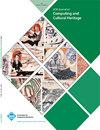Deep Learning for Identifying Iran’s Cultural Heritage Buildings in Need of Conservation Using Image Classification and Grad-CAM
IF 2.2
3区 计算机科学
Q3 COMPUTER SCIENCE, INTERDISCIPLINARY APPLICATIONS
引用次数: 0
Abstract
The cultural heritage buildings (CHB), which are part of mankind’s history and identity, are in constant danger of damage, or in extreme cases, complete destruction. Thus, it’s of utmost importance to preserve them by identifying the existent, or presumptive, defects using novel methods so that renovation processes can be done in a timely manner and with higher accuracy. The main goal of this research is to use new Deep Learning (DL) methods in the process of preserving CHBs (situated in Iran); a goal that has been neglected especially in developing countries such as Iran, as these countries still preserve their CHBs using manual, and even archaic, methods that need direct human supervision. Having proven their effectiveness and performance when it comes to processing images, the Convolutional Neural Networks (CNNs) are a staple in computer vision (CV) literacy and this paper is not exempt. When lacking enough CHB images, training a CNN from scratch would be very difficult and prone to overfitting; that’s why we opted to use a technique called transfer learning (TL) in which we used pre-trained ResNet, MobileNet, and Inception networks, for classification. Even more, the Grad-CAM was utilized to localize the defects to some extent. The final results were very favorable, compared to similar papers. We reached 94% in Precision, Recall, and F1-Score with our fine-tuned MobileNetV2 model, which showed a 4-5% improvement over other similar works. The final proposed model can pave the way for moving from manual to unmanned CHB conservation, hence an increase in accuracy and a decrease in human-induced errors.利用图像分类和Grad-CAM深度学习识别需要保护的伊朗文化遗产建筑
文化遗产建筑作为人类历史和身份的一部分,不断面临着被破坏的危险,在极端情况下,甚至被彻底摧毁。因此,通过使用新颖的方法识别存在的或可能存在的缺陷来保护它们,以便及时和更高的准确性地进行修复过程,这是至关重要的。本研究的主要目标是在保存CHBs(位于伊朗)的过程中使用新的深度学习(DL)方法;这一目标一直被忽视,尤其是在伊朗等发展中国家,因为这些国家仍然使用手工甚至古老的方法来保存他们的CHBs,需要直接的人工监督。卷积神经网络(cnn)在处理图像方面已经证明了其有效性和性能,是计算机视觉(CV)素养的主要内容,本文也不例外。当缺乏足够的CHB图像时,从头开始训练CNN将非常困难并且容易过度拟合;这就是为什么我们选择使用一种称为迁移学习(TL)的技术,其中我们使用预训练的ResNet, MobileNet和Inception网络进行分类。更重要的是,在一定程度上利用了gradcam来定位缺陷。与同类论文相比,最终的结果非常令人满意。我们使用经过微调的MobileNetV2模型,在精度、召回率和F1-Score方面达到了94%,比其他类似的工作提高了4-5%。最终提出的模型可以为从手动到无人操作的CHB保护铺平道路,从而提高准确性并减少人为错误。
本文章由计算机程序翻译,如有差异,请以英文原文为准。
求助全文
约1分钟内获得全文
求助全文
来源期刊

ACM Journal on Computing and Cultural Heritage
Arts and Humanities-Conservation
CiteScore
4.60
自引率
8.30%
发文量
90
期刊介绍:
ACM Journal on Computing and Cultural Heritage (JOCCH) publishes papers of significant and lasting value in all areas relating to the use of information and communication technologies (ICT) in support of Cultural Heritage. The journal encourages the submission of manuscripts that demonstrate innovative use of technology for the discovery, analysis, interpretation and presentation of cultural material, as well as manuscripts that illustrate applications in the Cultural Heritage sector that challenge the computational technologies and suggest new research opportunities in computer science.
 求助内容:
求助内容: 应助结果提醒方式:
应助结果提醒方式:


